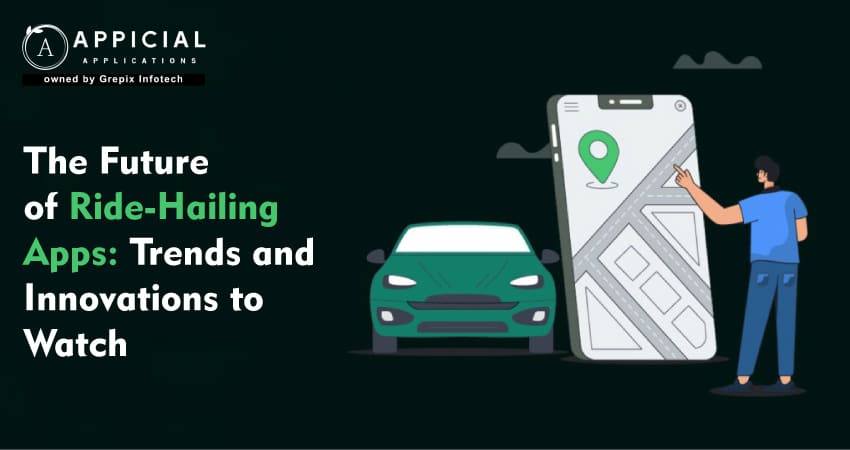
The Future of Ride-Hailing Apps: Trends and Innovations to Watch
The ride-hailing industry has revolutionized the way we think about transportation. Gone are the days when hailing a taxi meant standing on a street corner, waving frantically as cabs zipped by. With a few taps on a smartphone, a ride can now be summoned to virtually any location. Companies like Uber, Lyft, and Didi have become household names, disrupting traditional taxi services and introducing a new era of convenience.
As we look toward the future, ride-hailing apps are poised to undergo significant transformations. Technological advancements, shifting consumer preferences, and regulatory changes are shaping the next phase of this dynamic industry. This article explores the trends and innovations to redefine ride-hailing services in the coming years.
The ride-hailing industry has revolutionized transportation by providing unprecedented convenience through apps like Uber and Lyft. Looking to the future, significant transformations are expected due to technological advancements, changing consumer preferences, and regulatory shifts. Key trends include autonomous vehicles for cost reduction and increased safety, electrification with a shift to electric cars for sustainability, and integration with public transportation for a more cohesive network. Other innovations involve micro-mobility options like scooters and bikes, AI and data analytics for service optimization, personalization to enhance customer experience and expansion into new markets and services. Despite regulatory hurdles and profitability concerns, the industry is evolving toward a more sustainable and efficient future.
1 Autonomous Vehicles: The Self-Driving Revolution
One of the most anticipated developments in the ride-hailing sector is the integration of autonomous vehicles. Companies like Waymo, Tesla, and Cruise are making strides in self-driving technology, aiming to reduce the need for human drivers. The benefits are multifold:
- Cost Reduction: Eliminating the driver can significantly lower operational costs, potentially reducing fares for passengers.
- Increased Safety: Autonomous vehicles equipped with advanced sensors and AI can react faster than humans, potentially reducing accidents caused by human error.
- Efficiency: Self-driving cars can operate 24/7 without breaks, increasing the availability of rides.
However, challenges remain. Regulatory hurdles, technological limitations, and public trust issues need to be addressed before autonomous ride-hailing becomes mainstream. Pilot programs in select cities are currently testing the viability of these services, gathering data to improve performance and safety.
2 Electrification: Driving Towards Sustainability
The push for sustainable transportation is accelerating the adoption of electric vehicles (EVs) in the ride-hailing industry. Governments worldwide are implementing stricter emission regulations, and consumers are becoming more environmentally conscious. Ride-hailing companies are responding by:
- Incorporating EVs into Fleets: Uber and Lyft have announced plans to transition to all-electric fleets by the mid-2030s.
- Incentivizing Drivers: Offering bonuses and incentives to drivers who switch to electric or hybrid vehicles.
- Partnerships with Automakers: Collaborating with companies like Nissan and General Motors to secure access to EVs.
Shift to electric vehicles reduces carbon footprints but also lowers operating costs due to savings on fuel and maintenance. Infrastructure development, such as increased charging stations, is essential to support this transition.
3 Integration with Public Transportation
Ride-hailing apps are expanding beyond point-to-point transportation by integrating with public transit systems. This synergy aims to create a more cohesive and efficient transportation network. Key initiatives include:
- Multi-Modal Journey Planning: Apps providing options that combine ride-hailing with buses, trains, or bikes for the most efficient route.
- First-Mile/Last-Mile Solutions: Offering rides to and from transit hubs, making public transportation more accessible.
- Collaborations with Transit Authorities: Sharing data and resources to improve urban mobility planning.
By complementing rather than competing with public transit, ride-hailing services can alleviate congestion and reduce environmental impact.
4 Micro-Mobility: The Rise of Scooters and Bikes
Micro-mobility solutions like electric scooters and bikes are gaining popularity, especially in urban areas. Ride-hailing companies are diversifying their offerings to include these alternatives:
- Convenience: Ideal for short distances, micro-mobility options provide flexibility and ease of use.
- Environmental Benefits: Reduced emissions compared to car rides, contributing to greener cities.
- Cost-Effectiveness: Lower fares attract cost-conscious consumers.
Companies like Lime and Bird specialize in micro-mobility, while Uber and Lyft have integrated scooters and bikes into their platforms. For sustainable growth, issues like regulations, safety concerns, and vandalism must be addressed.
5 AI and Data Analytics: Enhancing Service Quality
Artificial Intelligence (AI) and data analytics are pivotal in optimizing ride-hailing services. Applications include:
- Dynamic Pricing: Adjusting fares based on demand, traffic, and availability to balance supply and demand.
- Route Optimization: Using real-time data to determine the fastest and most efficient routes.
- Predictive Maintenance: Monitoring vehicle health to prevent breakdowns and ensure safety.
- Personalization: Tailoring services based on user preferences and history.
Advanced algorithms improve the overall customer experience and operational efficiency increasing satisfaction and loyalty.
6Sustainability and Environmental Concerns
Beyond electrification, ride-hailing companies are adopting broader sustainability initiatives:
- Carbon Offsetting: Investing in environmental projects to offset emissions from rides.
- Green Certifications: Encouraging drivers to obtain eco-friendly certifications or use vehicles that meet specific environmental standards.
- Community Programs: Supporting local environmental efforts and promoting sustainable practices.
These efforts not only address environmental concerns but also enhance corporate social responsibility profiles.
Also Read: How AI is Transforming Logistics Industry – Key Business Opportunities and Challenges
7Regulation and Policy Changes
The ride-hailing industry operates within a complex regulatory landscape that varies by region. Future developments include:
- Standardization of Laws: Efforts to create uniform regulations across jurisdictions to simplify operations.
- Labor Classification: Debates over whether drivers should be considered employees or independent contractors, impacting benefits and company responsibilities.
- Safety Regulations: Implementing stricter safety protocols, background checks, and vehicle inspections.
Companies must navigate these changes carefully to maintain compliance and public trust.
8Ride-Sharing and Pooling: Maximizing Efficiency
Ride-sharing services that allow multiple passengers to share a ride are gaining traction. Benefits include:
- Cost Savings: Lower fares for passengers willing to share rides.
- Reduced Traffic: Fewer vehicles on the road can alleviate congestion.
- Environmental Impact: Decreased emissions per passenger.
However, the COVID-19 pandemic temporarily dampened enthusiasm for shared rides due to health concerns. As conditions improve, ride-sharing is expected to rebound, supported by enhanced safety measures.
9Personalization and Customer Experience
Enhancing the user experience is a key focus area. Innovations include:
- Customizable Preferences: Users can select music, temperature settings, or conversation preferences.
- Loyalty Programs: Rewarding frequent users with discounts, priority pickups, or exclusive services.
- Accessibility Features: Providing options for riders with disabilities, such as wheelchair-accessible vehicles.
A personalized experience can differentiate services in a competitive market, fostering customer retention.
10Expansion into New Markets and Services
Ride-hailing companies are exploring new avenues for growth:
- Global Expansion: Entering emerging markets in Asia, Africa, and Latin America where demand is rising.
- Delivery Services: Leveraging networks for food, grocery, and parcel deliveries, as seen with Uber Eats and DoorDash.
- Subscription Models: Offering monthly plans with benefits like discounted rides or fixed rates.
Diversification mitigates risks associated with ride-hailing alone and opens up additional revenue streams.
11Payment Innovations
Advancements in payment technologies are streamlining transactions.
- Digital Wallets: Integration with services like Apple Pay, Google Wallet, and proprietary wallets.
- Cryptocurrency: Exploring acceptance of cryptocurrencies for rides.
- Contactless Payments: Enhancing safety and convenience with touch-free payment options.
Simplifying the payment process enhances user satisfaction and can attract tech-savvy customers.
12Safety and Security Enhancements
Ensuring the safety of both passengers and drivers is paramount:
- In-App Emergency Features: Panic buttons, real-time location sharing, and direct lines to emergency services.
- Background Checks: Rigorous screening processes for drivers.
- Training Programs: Educating drivers on safety protocols and customer service.
Technological solutions like in-car cameras and AI-driven monitoring can further enhance security measures.
13Challenges Facing the Ride-Hailing Industry
While the future is promising, the industry faces significant challenges:
- Regulatory Hurdles: Navigating complex laws and potential pushback from traditional taxi services.
- Competition: Battling for market share with existing rivals and new entrants.
- Profitability: High operational costs and competitive pricing pressures impact margins.
- Safety and Liability: Addressing concerns over accidents, assaults, and other incidents involving drivers or passengers.
Companies must innovate and adapt strategies to overcome these obstacles and maintain sustainable growth.
Conclusion
The ride-hailing industry stands at a crossroads of innovation and transformation. Autonomous vehicles, electrification, and AI are set to redefine transportation paradigms. By embracing sustainability, enhancing customer experiences, and expanding service offerings, ride-hailing apps can continue to disrupt and lead the mobility sector.
Appicial Applications is at the forefront of this evolution, providing cutting-edge solutions that align with these emerging trends. Specializing in custom ride-hailing app development, We empower businesses to adapt to the changing landscape with scalable and innovative platforms. They are prepared to take on opportunities and challenges in the future thanks to their dedication to innovation and customer-centric design. Success in this dynamic industry is contingent upon addressing regulatory challenges, ensuring safety, and achieving profitability. Collaboration with technology partners like Appicial Applications, investment in advanced technologies, and a focus on customer needs will be critical.
Looking out to start your own venture like Uber? Try out our HireMe Uber Clone, the easiest way to kick-start your taxi business.






